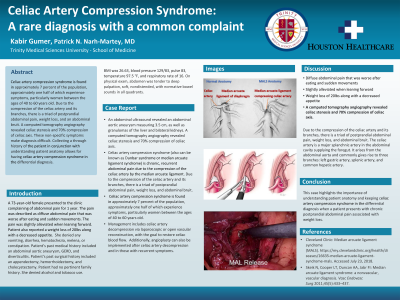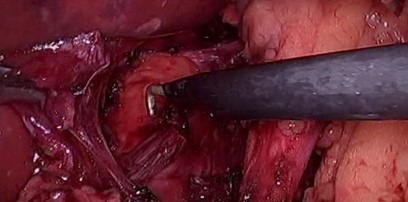Tuesday Poster Session
Category: Small Intestine
P4149 - Celiac Artery Compression Syndrome: A Rare Diagnosis for a Common Complaint
Tuesday, October 24, 2023
10:30 AM - 4:00 PM PT
Location: Exhibit Hall

Has Audio

Kabir S. Gumer, BS
Trinity School of Medicine
Gaithersburg, MD
Presenting Author(s)
Kabir S. Gumer, BS1, Patrick Narh-Martey, MD2
1Trinity School of Medicine, Gaithersburg, MD; 2Houston Medical Center, Warner Robins, GA
Introduction: A 73-year-old female presented to the clinic complaining of abdominal pain for 1 year. The pain was described as diffuse abdominal pain that was worse after eating and sudden movements. The pain was slightly alleviated when leaning forward. Patient also reported a weight loss of 20lbs along with a decreased appetite. She denied any vomiting, diarrhea, hematochezia, melena, or constipation. Patient’s past medical history included an abdominal aortic aneurysm, GERD, and diverticulitis. Patient’s past surgical history included an appendectomy, hemorrhoidectomy, and cholecystectomy. Patient had no pertinent family history. She denied alcohol and tobacco use. BMI was 26.63, blood pressure 129/83, pulse 83, temperature 97.5 °F, and respiratory rate of 16. On physical exam, abdomen was tender to deep palpation, soft, nondistended, with normative bowel sounds in all quadrants.
Case Description/Methods: An abdominal ultrasound revealed an abdominal aortic aneurysm measuring 3.5 cm, as well as granulomas of the liver and bilateral kidneys. A computed tomography angiography revealed celiac stenosis and 70% compression of celiac axis.
Celiac artery compression syndrome (also known as Dunbar syndrome or Median Arcuate Ligament Syndrome) is chronic, recurrent abdominal pain due to the compression of the celiac artery by the median arcuate ligament. Due to the compression of the celiac artery and its branches, there is a triad of postprandial abdominal pain, weight loss, and abdominal bruit.
Celiac artery compression syndrome is found in approximately 7 percent of the population with a predisposition towards women between the ages of 40 to 60 years. Approximately half of these patients experience symptoms.
Management includes celiac artery decompression via laparoscopic or open vascular reconstruction, with the goal to restore celiac blood flow. Additionally, angioplasty can also be implemented after celiac artery decompression and in those with recurrent symptoms.
Discussion: This case highlights the importance of understanding patient anatomy and keeping celiac artery compression syndrome in the differential diagnosis when a patient presents with chronic postprandial abdominal pain associated with weight loss.

Disclosures:
Kabir S. Gumer, BS1, Patrick Narh-Martey, MD2. P4149 - Celiac Artery Compression Syndrome: A Rare Diagnosis for a Common Complaint, ACG 2023 Annual Scientific Meeting Abstracts. Vancouver, BC, Canada: American College of Gastroenterology.
1Trinity School of Medicine, Gaithersburg, MD; 2Houston Medical Center, Warner Robins, GA
Introduction: A 73-year-old female presented to the clinic complaining of abdominal pain for 1 year. The pain was described as diffuse abdominal pain that was worse after eating and sudden movements. The pain was slightly alleviated when leaning forward. Patient also reported a weight loss of 20lbs along with a decreased appetite. She denied any vomiting, diarrhea, hematochezia, melena, or constipation. Patient’s past medical history included an abdominal aortic aneurysm, GERD, and diverticulitis. Patient’s past surgical history included an appendectomy, hemorrhoidectomy, and cholecystectomy. Patient had no pertinent family history. She denied alcohol and tobacco use. BMI was 26.63, blood pressure 129/83, pulse 83, temperature 97.5 °F, and respiratory rate of 16. On physical exam, abdomen was tender to deep palpation, soft, nondistended, with normative bowel sounds in all quadrants.
Case Description/Methods: An abdominal ultrasound revealed an abdominal aortic aneurysm measuring 3.5 cm, as well as granulomas of the liver and bilateral kidneys. A computed tomography angiography revealed celiac stenosis and 70% compression of celiac axis.
Celiac artery compression syndrome (also known as Dunbar syndrome or Median Arcuate Ligament Syndrome) is chronic, recurrent abdominal pain due to the compression of the celiac artery by the median arcuate ligament. Due to the compression of the celiac artery and its branches, there is a triad of postprandial abdominal pain, weight loss, and abdominal bruit.
Celiac artery compression syndrome is found in approximately 7 percent of the population with a predisposition towards women between the ages of 40 to 60 years. Approximately half of these patients experience symptoms.
Management includes celiac artery decompression via laparoscopic or open vascular reconstruction, with the goal to restore celiac blood flow. Additionally, angioplasty can also be implemented after celiac artery decompression and in those with recurrent symptoms.
Discussion: This case highlights the importance of understanding patient anatomy and keeping celiac artery compression syndrome in the differential diagnosis when a patient presents with chronic postprandial abdominal pain associated with weight loss.

Figure: MALS release
Disclosures:
Kabir Gumer indicated no relevant financial relationships.
Patrick Narh-Martey indicated no relevant financial relationships.
Kabir S. Gumer, BS1, Patrick Narh-Martey, MD2. P4149 - Celiac Artery Compression Syndrome: A Rare Diagnosis for a Common Complaint, ACG 2023 Annual Scientific Meeting Abstracts. Vancouver, BC, Canada: American College of Gastroenterology.
